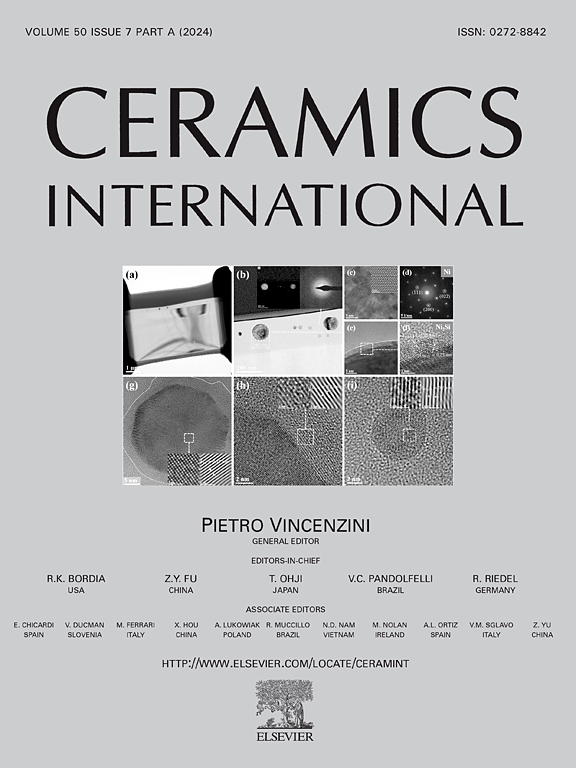A novel phosphate-based phosphor for multifunctional applications realized by energy transmission and color change
IF 5.6
2区 材料科学
Q1 MATERIALS SCIENCE, CERAMICS
引用次数: 0
Abstract
The concept of healthy lighting has led to the emergence of warm white light-emitting phosphors as a prominent research focus within the lighting industry. In this study, a series of phosphors composed of Ca8ZnY(PO4)7 (CZYP) doped with Dy3+ and Sm3+ were synthesized through the high-temperature solid-state technique. The crystal structure, optical properties, and energy transfer processes of the phosphors were systematically investigated. An effective energy transfer strategy was successfully implemented, achieving a remarkable energy transfer efficiency of 41.3 % between Dy3+ and Sm3+ ions when excited at 363 nm. The 365 nm UV chip was used with the synthesized phosphor to encapsulate LEDs, resulting in a low color temperature (CCT, 3438 K) and a high color rendering index (Ra, 82.1) for warm white light emission. Additionally, the emission spectrum of the phosphor satisfied the spectral criteria necessary for chlorophyll synthesis. The anti-counterfeiting of the phosphor was further investigated, leading to a multi-color switching model characterized by intuitive visualization and straightforward identification. These results suggest that the synthesized phosphors are promising for health lighting, plant lighting, and optical anti-counterfeiting applications.
一种新型的磷酸盐基荧光粉,通过能量传输和颜色变化实现多功能应用
健康照明的概念导致暖白色发光荧光粉的出现,成为照明行业的一个突出研究重点。本研究通过高温固相技术合成了一系列由掺杂Dy3+和Sm3+的Ca8ZnY(PO4)7 (CZYP)组成的荧光粉。系统地研究了荧光粉的晶体结构、光学性质和能量传递过程。成功地实现了一种有效的能量转移策略,在363nm激发时,Dy3+和Sm3+离子之间的能量转移效率达到了41.3%。用合成的荧光粉封装365 nm紫外芯片,获得了低色温(CCT, 3438 K)和高显色指数(Ra, 82.1)的暖白光发射。此外,荧光体的发射光谱满足叶绿素合成所需的光谱标准。进一步研究了该荧光粉的防伪性能,建立了一种直观、直观、识别简单的多色切换模型。这些结果表明,合成的荧光粉在健康照明、植物照明和光学防伪方面具有广阔的应用前景。
本文章由计算机程序翻译,如有差异,请以英文原文为准。
求助全文
约1分钟内获得全文
求助全文
来源期刊

Ceramics International
工程技术-材料科学:硅酸盐
CiteScore
9.40
自引率
15.40%
发文量
4558
审稿时长
25 days
期刊介绍:
Ceramics International covers the science of advanced ceramic materials. The journal encourages contributions that demonstrate how an understanding of the basic chemical and physical phenomena may direct materials design and stimulate ideas for new or improved processing techniques, in order to obtain materials with desired structural features and properties.
Ceramics International covers oxide and non-oxide ceramics, functional glasses, glass ceramics, amorphous inorganic non-metallic materials (and their combinations with metal and organic materials), in the form of particulates, dense or porous bodies, thin/thick films and laminated, graded and composite structures. Process related topics such as ceramic-ceramic joints or joining ceramics with dissimilar materials, as well as surface finishing and conditioning are also covered. Besides traditional processing techniques, manufacturing routes of interest include innovative procedures benefiting from externally applied stresses, electromagnetic fields and energetic beams, as well as top-down and self-assembly nanotechnology approaches. In addition, the journal welcomes submissions on bio-inspired and bio-enabled materials designs, experimentally validated multi scale modelling and simulation for materials design, and the use of the most advanced chemical and physical characterization techniques of structure, properties and behaviour.
Technologically relevant low-dimensional systems are a particular focus of Ceramics International. These include 0, 1 and 2-D nanomaterials (also covering CNTs, graphene and related materials, and diamond-like carbons), their nanocomposites, as well as nano-hybrids and hierarchical multifunctional nanostructures that might integrate molecular, biological and electronic components.
 求助内容:
求助内容: 应助结果提醒方式:
应助结果提醒方式:


